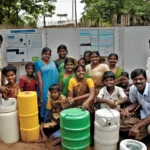New Delhi, India – 2025
In the context of contemporary educational reforms, especially with the implementation of the National Education Policy (NEP) 2020, the role and relevance of playground space in schools are being reevaluated. While traditional schooling systems have long emphasized the importance of large playgrounds for physical development and recreation, evolving educational paradigms suggest a nuanced view where the necessity of such spaces is balanced with other priorities such as academic excellence, technological integration, and holistic development. Here’s a deeper look into the ongoing relevance of playground spaces in modern schooling.
Balancing Physical and Academic Growth
1. Holistic Development:
The NEP underscores the importance of holistic development, which includes physical, cognitive, emotional, and social growth. Playgrounds play a crucial role in promoting physical health and social interaction among students. Activities facilitated in these spaces help in developing teamwork, leadership, and social skills. Thus, while the approach to education is becoming more inclusive of diverse learning environments, the value of physical play and the skills it fosters remains significant.
2. Wellbeing and Mental Health:
Modern educational research continues to support the idea that physical activity is essential for mental health. Playgrounds offer a necessary break from the academic rigors of the classroom, helping to reduce stress and boost mood levels among students. This aspect of school life is crucial in an era where student wellbeing is as prioritized as academic achievement.
Technological Alternatives and Space Optimization
1. Digital Integration:
With the NEP’s push towards incorporating technology in education, digital platforms and virtual reality are being used to simulate physical activities and sports. These technologies can provide alternative means to engage students physically, offering flexibility in how physical education is delivered, especially in schools with limited outdoor space.
2. Multi-Use Spaces:
Urban schools, facing constraints on expansive playgrounds, are increasingly designing multi-purpose spaces that can be used for both educational and physical activities. This efficient use of space aligns with the NEP’s emphasis on flexibility and innovation in educational environments.
Community Resources as Extensions
1. Community Engagement:
Schools without large playgrounds are encouraged to utilize community parks, sports facilities, and other resources. This not only makes up for the lack of space but also helps integrate the school more closely with the community, opening up students to wider social and environmental interactions.
2. Partnerships for Physical Education:
Collaborations with local sports clubs and recreational centers can supplement the physical education needs of students, ensuring they receive the necessary physical training and activity without requiring large school-owned playgrounds.
Evolving Educational Models
Globally, there is an increasing shift towards educational models that do not necessarily rely on large physical infrastructures. Schools in many parts of the world, particularly in urban settings, are focusing on maximizing limited spaces by employing innovative designs that accommodate both learning and physical activity in compact areas.
Conclusion
While the relevance of playground space in modern schooling is evolving, it is clear that such spaces, whether on school grounds or accessed through community resources, continue to play an essential role in the educational landscape. They contribute not only to the physical development of students but also to their emotional and social wellbeing. As educational policies like the NEP promote more integrated and flexible learning environments, the approach to playground space may become more creative and less traditional, yet its core benefits remain undeniable. Schools must strive to balance these aspects to provide a comprehensive education that nurtures all facets of student development.








